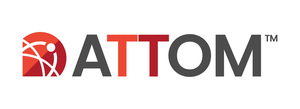
National zombie foreclosure rate edges down to 3.25 percent;
National vacancy rate dips slightly to 1.3 percent
IRVINE, Calif., Oct. 30, 2025 /PRNewswire/ -- ATTOM, a leading curator of land, property data, and real estate analytics, today released its fourth-quarter 2025 Vacant Property and Zombie Foreclosure Report showing that 1.32 percent of residential properties in the United States, about 1.4 million homes, were vacant. That was down slightly from a 1.33 percent national vacancy rate the previous quarter as the country continues to experience high demand for houses.
The report analyzes publicly recorded real estate data collected by ATTOM — including foreclosure status, equity and owner-occupancy status — matched against monthly updated vacancy data. (See full methodology below).
The analysis shows that 228,943 residential properties nationwide were in the process of foreclosure during the fourth quarter. Of those, 3.25 percent, or about 7,448 homes, were "zombie" properties, meaning they had been abandoned by their owner prior to the conclusion of the foreclosure proceedings. That was down from a 3.38 percent zombie rate the previous quarter.
"These continuously low vacancy rates that the nation has held steady at around 1.4 percent for nearly four years, show that record high prices haven't dampened the demand for homes," said Rob Barber, CEO of ATTOM. "It's a good sign for local housing markets that even as we've seen foreclosure filings increase, the rate of homes in foreclosure that are abandoned is going down."
2025 Zombie Foreclosure Infographic
Low zombie rates fall further in most states
The number of zombie properties rose quarter-over-quarter in 21 states and the District of Columbia, but by small margins and as few as a single additional zombie property in some states.
Among states with at least 50 zombie properties, the biggest quarter-over-quarter increases in zombie properties came in Oregon (up 37.8 percent to 51 zombie properties in the fourth quarter); Nevada (up 31.1 percent to 59); Georgia (up 15.6 percent to 74); Ohio (up 9 percent to 606); and Arizona (up 6.3 percent to 68).
Those with the largest quarter-over-quarter drops in zombie properties were Oklahoma (down 23 percent to 57); Indiana (down 12.7 percent to 219); California (down 12.3 percent to 272); Michigan (down 11.3 percent to 63); and Iowa (down 9.3 percent to 107).
Vacancies rare in New England states
The states with the highest overall home vacancy rates in the fourth quarter were Oklahoma (2.4 percent); Kansas (2.3 percent); Alabama (2.2 percent); Missouri (2.1 percent); and West Virginia (2.1 percent).
The lowest overall vacancy rates were in New Hampshire (0.3 percent); Vermont (0.4 percent); New Jersey (0.5 percent); Idaho (0.5 percent); and Connecticut (0.5 percent).
Midwestern cities see highest zombie rates
Zombie property rates were below the national rate of 3.25 percent in 56 percent (75) of the 133 metropolitan statistical areas in our analysis with at least 100,000 properties and 100 properties in the foreclosure process.
Of those metro areas, the ones with the highest rates of pre-foreclosure homes that had been abandoned, or become "zombies," in the fourth quarter were Cedar Rapids, IA (14 percent of pre-foreclosure homes abandoned); Peoria, IL (11.9 percent); Wichita, KS (11.8 percent); Cleveland, OH (10.8 percent); and Youngstown, OH (10.6 percent).
Three of the largest metro areas had no zombie properties in the fourth quarter: Grand Rapids, MI; Nashville, TN; and Raleigh, NC. The next lowest zombie rates were in Atlantic City, NJ (0.2 percent); Provo, UT (0.3 percent); Trenton, NJ (0.3 percent); Oxnard, CA (0.7 percent); and Stockton, CA (0.8 percent).
Vacancy rates higher for investment properties
Homes owned by institutional investors were slightly more likely than typical homes to be vacant in the fourth quarter. Of the 880,347 investor-owned properties nationwide, 3.5 percent were unoccupied compared to the overall national rate of 3.3 percent.
The states with the highest vacancy rates for investor-owned homes were Indiana (7.1 percent); Illinois (6.1 percent); Alabama (5.9 percent); Oklahoma (5.9 percent); and Kansas (5.8 percent).
The lowest vacancy rates for investor-owned properties were in New Hampshire (0.8 percent); Vermont (1 percent); Idaho (1.3 percent); Utah (1.5 percent); and North Dakota (1.5 percent).
Some zip codes see far higher concentration of zombies
Of the 2,247 zip codes in ATTOM's analysis with at least 1,000 properties and 25 in pre-foreclosure in the fourth quarter, about 64.6 percent (1,452) had zombie property rates below the national rate of 3.25 percent.
The zip codes with the highest zombie home rates were 91001 in Altadena, CA (56 percent); 52404 in Cedar Rapids, IA (39.3 percent); 44103 in Cleveland, OH (34.6 percent); 33703 in Saint Petersburg, FL (32.8 percent); and 33708 in Saint Petersburg, FL (32.7 percent).
Conclusion
ATTOM's fourth-quarter 2025 analysis found that 1.32 percent of U.S. residential properties were vacant, down slightly from 1.334 percent the previous quarter. The share of zombie foreclosures also ticked lower, dropping from 3.38 percent in Q3 to 3.25 percent in Q4, representing about 7,448 homes. Vacancy and zombie foreclosure rates declined in most states, with notable drops in California, Indiana, and Florida, while modest increases were seen in Ohio, Nevada, and Oregon.
Report Methodology
ATTOM analyzed county tax assessor data for 104.3 million residential properties for vacancy, broken down by foreclosure status and owner-occupancy status in the fourth quarter of 2025. Only metropolitan statistical areas with at least 100,000 residential properties, counties with at least 50,000 residential properties and zip codes with at least 1,000 residential properties were included in the analysis.
About ATTOM
ATTOM powers innovation across industries with premium property data and analytics covering 158 million U.S. properties—99% of the population. Our multi-sourced real estate data includes property tax, deed, mortgage, foreclosure, environmental risk, natural hazard, neighborhood and geospatial boundary information, all validated through a rigorous 20-step process and linked by a unique ATTOM ID.
From flexible delivery solutions—such as Property Data APIs, Bulk File Licenses, Cloud Delivery, Real Estate Market Trends—to AI-Ready datasets, ATTOM fuels smarter decision-making across industries including real estate, mortgage, insurance, government, and more.
Media Contact:
Megan Hunt
[email protected]
Data and Report Licensing:
[email protected]
SOURCE ATTOM







Share this article